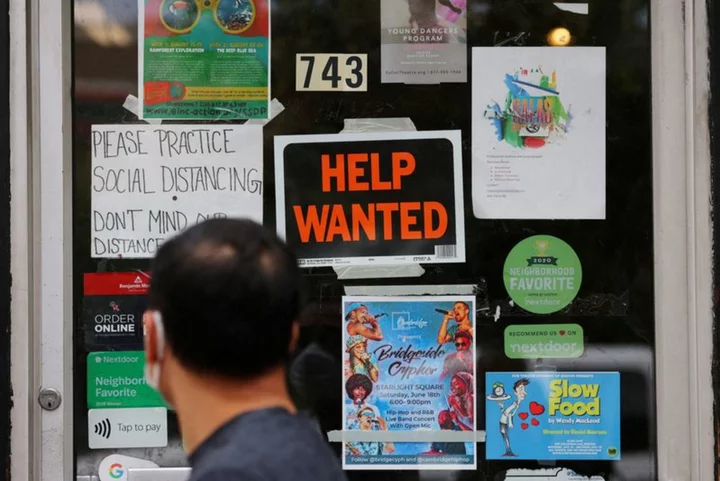By Dan Burns
U.S. employers have yet to ramp up layoffs as many economists have predicted, data out on Thursday showed in the latest indication of a job market refusing to buckle in the face of the Federal Reserve's efforts to slow it down.
New filings for state unemployment benefits fell unexpectedly last week to the lowest level since February, and the ranks of those receiving jobless benefits for more than a week slid in the week before that to the lowest since July, the Labor Department said in its weekly reading of layoff activity across the country.
While other data on the job market recently have shown signs it is softening from the extremely tight conditions that arose during the COVID-19 pandemic, Thursday's data reinforces the view that it remains robust by historical standards.
That may lead the Fed - which has jacked up interest rates aggressively over the last 18 months - to keep borrowing costs high for some time in order to bring inflation back to its 2% target.
Indeed, while a separate Labor Department report on Thursday showed labor cost pressures had eased substantially in the second quarter and worker productivity jumped by the most in nearly three years, those improvements are unlikely to be sufficient to allow the Fed to let its guard down in the battle to subdue inflation.
"The Fed still needs to see labor market conditions weaken further to be confident it is on track to bring inflation back to target," Michael Pearce, lead U.S. economist at Oxford Economics, wrote.
CLAIMS DROP
Initial claims for state unemployment benefits fell 13,000 to 216,000 in the week ended Sept. 2 from a revised 229,000 in the prior week, the Labor Department said on Thursday. That was the lowest since the same level was touched in the week ended Feb. 11 and it marked the fourth straight weekly decline.
Economists polled by Reuters had forecast new claims would rise to 234,000 in the latest week.
Meanwhile, the rolls of those continuing to receive jobless benefits beyond the first week fell by 40,000 to 1.679 million in the week ended Aug. 26 from a revised 1.719 million a week earlier. That was the lowest since the same level was hit in the week ended July 15.
Continued claims, followed by some economists as a proxy for hiring, had climbed notably from last year at this time through early April when they briefly rose above 1.85 million. Since then, however, they have declined and the latest reading is well below the 1.9 million average over the five years before the pandemic, also a period when the job market was viewed as robust.
Overall, the jobless claims figures do not indicate any danger of the U.S. job market rolling over in the near term, with recorded layoff activity still low even though corporate layoff announcements have recently increased.
"The claims data do not show any real evidence of a pickup in layoff activity," Jefferies U.S. economist Thomas Simons wrote after the data release. "There have been brief periods of elevated counts during 2023, specifically in June, but these periods have been short-lived and often explainable by special factors."
The data point to laid-off workers finding new jobs with relative ease or that "realized layoff activity is far less than what is announced by large businesses," Simons said. Taken altogether, the figures suggest the "chances of a soft landing in the labor market seem to be increasing somewhat."
Last week, the Labor Department said job growth picked up in August, although employment gains reported in the previous two months were revised sharply lower in an indication that labor market conditions were loosening. The unemployment rate rose unexpectedly to 3.8% from 3.5%, but that was driven by an increase in the labor force participation rate to the highest in more than three years.
PRODUCTIVITY REBOUND
The Labor Department on Thursday separately said worker productivity rebounded in the second quarter, albeit not to the degree initially reported.
Nonfarm productivity - measuring hourly output per worker - increased at a 3.5% annualized rate in the period from April through June - the highest since the third quarter of 2020 - versus a -1.2% reading in the first three months of the year. Second-quarter productivity growth had initially been estimated at 3.7%.
The report also showed unit labor costs, a key focus of the Fed, rose at a 2.2% annualized rate, a somewhat faster pace than the 1.6% rate initially reported, but softer than the 3.3% rate in the first quarter.
While those developments will be welcome news to the Fed -- since improvements in productivity and easing of labor costs both factor favorably in the bid to further lower inflation from the 40-year highs experienced about a year ago -- officials at the central bank are unlikely any time soon to relax the pressure they are exerting on the economy.
Still, it does add to the case for holding their policy rate unchanged at the current 5.25% to 5.50% range when officials gather in Washington on Sept. 19-20 for their next rate-setting meeting.
"The trend over the past year is clear - wage pressures have moderated, which supports the case for holding rates unchanged at upcoming meetings," Oxford's Pearce wrote.
(Reporting by Dan Burns; Editing by Chizu Nomiyama, Paul Simao and Andrea Ricci)









